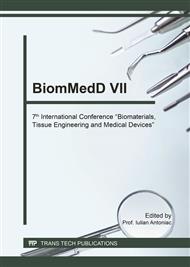[1]
Witte F., Kaese V., Haferkamp H., Switzer E., Meyer-Lindenberg A., Wirth C.J., Windhagen H., In vivo corrosion of four magnesium alloys and the associated bone response, Biomaterials 26 (2005) 3557–3563.
DOI: 10.1016/j.biomaterials.2004.09.049
Google Scholar
[2]
Zakiyuddin A., Lee K., Effect of a small addition of zinc and manganese to Mg–Ca based alloys on degradation behavior in physiological media, Journal of Alloys and Compounds 629 (2015) 274–283.
DOI: 10.1016/j.jallcom.2014.12.181
Google Scholar
[3]
Adam R., Gheorghiu N., Orban H., Antoniac I.V., Barbilian A., Evolution toward new bioabsorbable material for osteosynthesis implants used in foot and ankle surgery, Archives of the Balkan Medical Union, 51(2) (2016) 190-198.
Google Scholar
[4]
Farraro K.F., Kim K.E., Woo S.L., Flowers J.R., McCullough M.B., Revolutionizing orthopaedic biomaterials: the potential of biodegradable and bioresorbable magnesium-based materials for functional tissue engineering, J. Biomech. 47 (2014).
DOI: 10.1016/j.jbiomech.2013.12.003
Google Scholar
[5]
Razavi M., Fathi M.H., Savabi O., Boroni M., A Review of degradation properties of Mg based biodegradable implants, Research and Reviews in Materials Science and Chemistry, 1(1) (2012) 15-58.
Google Scholar
[6]
Bita AI, Antoniac A, Cotrut C, Vasile E, Ciuca I, Niculescu M, Antoniac I, In vitro Degradation and Corrosion Evaluation of Mg-Ca Alloys for Biomedical Applications, JOAM, 18(3-4) (2016) 394-398.
DOI: 10.1080/01694243.2016.1171569
Google Scholar
[7]
Li N., Zheng Y., Novel Magnesium Alloys Developed for Biomedical Application: A Review, J. Mater. Sci. Technol. 29(6) (2013) 489e502.
Google Scholar
[8]
Li Z., Gu X., Lou S., Zheng Y., The development of binary Mg–Ca alloys for use as biodegradable materials within bone, Biomaterials 29(10) (2008) 1329–1344.
DOI: 10.1016/j.biomaterials.2007.12.021
Google Scholar
[9]
Kim W. C., Kim J.G., Lee J.Y., Seok H.K., Influence of Ca on the corrosion properties of magnesium for biomaterials, Materials Letters, 62 (25) (2008) 4146–4148.
DOI: 10.1016/j.matlet.2008.06.028
Google Scholar
[10]
Rau J.V., Antoniac I., Fosca M., De Bonis A., Blajan A.I., Cotrut C., Graziani V., Curcio M., Cricenti A., Niculescu M., Ortenzi M., Teghil R., Glass-ceramic coated Mg-Ca alloys for biomedical implant applications, Mater Sci Eng C Mater Biol Appl., 64 (2016).
DOI: 10.1016/j.msec.2016.03.100
Google Scholar
[11]
Mareci D., Bolat G., Izquierdo J., Crimu C., Munteanu C., Antoniac I., Souto R.M., Electrochemical characteristics of bioresorbable binary MgCa alloys in Ringer's solution: Revealing the impact of local pH distributions during in-vitro dissolution, Mater Sci Eng C Mater Biol Appl., 60 (2016).
DOI: 10.1016/j.msec.2015.11.069
Google Scholar
[12]
Feser K., Kietzmann M., Baumer W., Krause C., Bach F.W., Effects of degradable Mg-Ca alloys on dendritic cell function, J. Biomater. Appl. 25 (2011) 685–697.
DOI: 10.1177/0885328209360424
Google Scholar
[13]
Cha P.R., Han H.S., Yang G.F., Seok H.K., Biodegradability engineering of biodegradable Mg alloys: Tailoring the electrochemical properties and microstructure of constituent phases, Scientific Reports 3: 2367 (2013) 1-6.
DOI: 10.1038/srep02367
Google Scholar
[14]
Thomann M., Krause C., Bormann D., von der Hoh N., Windhagen H., Meyer-Lindenberg A., Comparison of the resorbable magnesium alloys LAE442 und MgCa0. 8 concerning their mechanical properties, their progress of degradation and the bone-implant contact after 12 months implantation duration in a rabbit model, Materialwiss Werksttech, 40 (1-2) (2009).
DOI: 10.1002/mawe.200800412
Google Scholar


